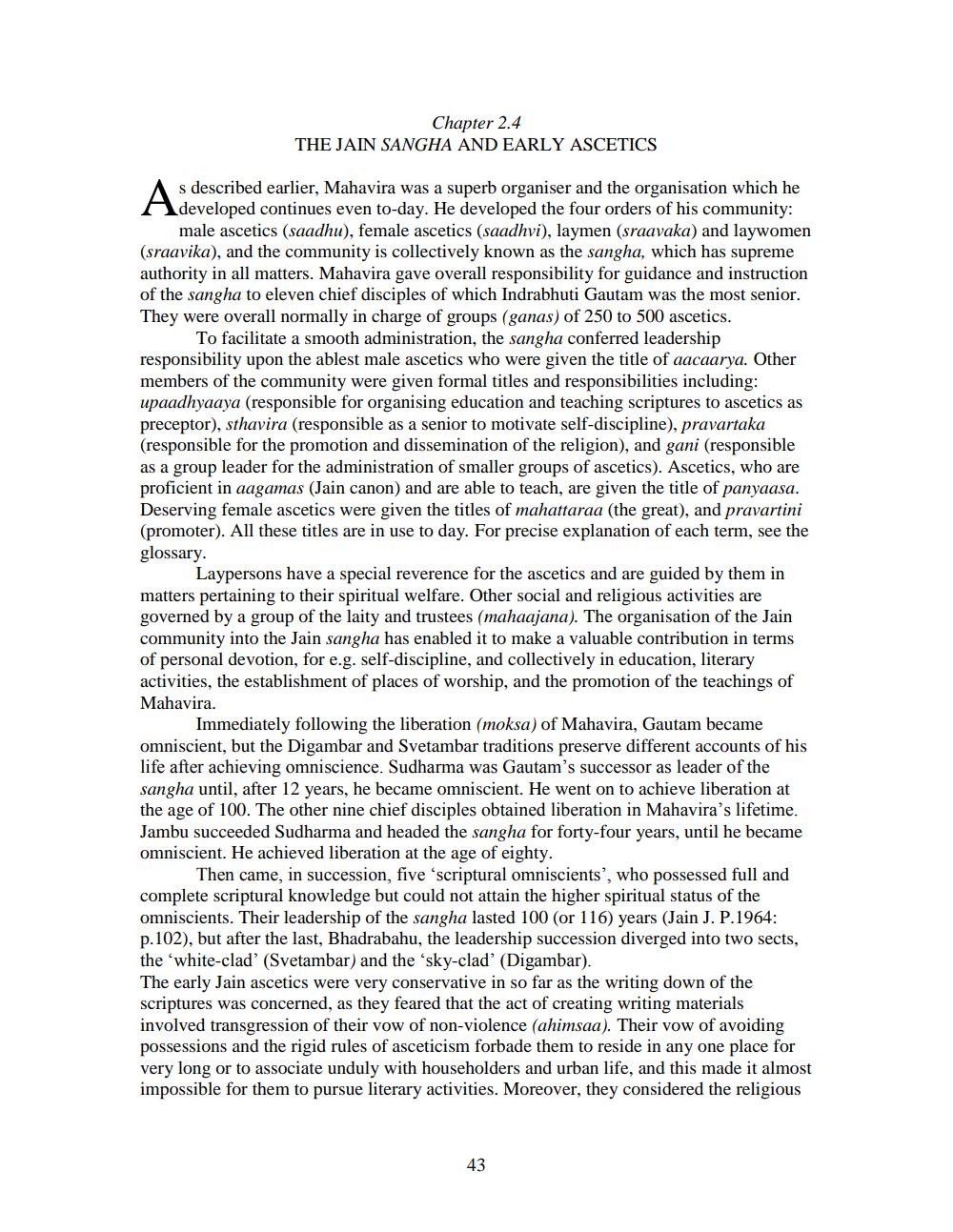________________
Chapter 2.4 THE JAIN SANGHA AND EARLY ASCETICS
s described earlier, Mahavira was a superb organiser and the organisation which he A developed continues even to-day. He developed the four orders of his community:
male ascetics (saadhu), female ascetics (saadhvi), laymen (sraavaka) and laywomen (sraavika), and the community is collectively known as the sangha, which has supreme authority in all matters. Mahavira gave overall responsibility for guidance and instruction of the sangha to eleven chief disciples of which Indrabhuti Gautam was the most senior. They were overall normally in charge of groups (ganas) of 250 to 500 ascetics.
To facilitate a smooth administration, the sangha conferred leadership responsibility upon the ablest male ascetics who were given the title of aacaarya. Other members of the community were given formal titles and responsibilities including: upaadhyaaya (responsible for organising education and teaching scriptures to ascetics as preceptor), sthavira (responsible as a senior to motivate self-discipline), pravartaka (responsible for the promotion and dissemination of the religion), and gani (responsible as a group leader for the administration of smaller groups of ascetics). Ascetics, who are proficient in aagamas (Jain canon) and are able to teach, are given the title of panyaasa. Deserving female ascetics were given the titles of mahattaraa (the great), and pravartini (promoter). All these titles are in use to day. For precise explanation of each term, see the glossary.
Laypersons have a special reverence for the ascetics and are guided by them in matters pertaining to their spiritual welfare. Other social and religious activities are governed by a group of the laity and trustees (mahaajana). The organisation of the Jain community into the Jain sangha has enabled it to make a valuable contribution in terms of personal devotion, for e.g. self-discipline, and collectively in education, literary activities, the establishment of places of Worship, and the promotion of the teachings of Mahavira.
Immediately following the liberation (moksa) of Mahavira, Gautam became omniscient, but the Digambar and Svetambar traditions preserve different accounts of his life after achieving omniscience. Sudharma was Gautam's successor as leader of the sangha until, after 12 years, he became omniscient. He went on to achieve liberation at the age of 100. The other nine chief disciples obtained liberation in Mahavira's lifetime. Jambu succeeded Sudharma and headed the sangha for forty-four years, until he became omniscient. He achieved liberation at the age of eighty.
Then came, in succession, five 'scriptural omniscients', who possessed full and complete scriptural knowledge but could not attain the higher spiritual status of the omniscients. Their leadership of the sangha lasted 100 (or 116) years (Jain J. P.1964: p.102), but after the last, Bhadrabahu, the leadership succession diverged into two sects, the 'white-clad' (Svetambar) and the 'sky-clad' (Digambar). The early Jain ascetics were very conservative in so far as the writing down of the scriptures was concerned, as they feared that the act of creating writing materials involved transgression of their vow of non-violence (ahimsaa). Their vow of avoiding possessions and the rigid rules of asceticism forbade them to reside in any one place for very long or to associate unduly with householders and urban life, and this made it almost impossible for them to pursue literary activities. Moreover, they considered the religious




